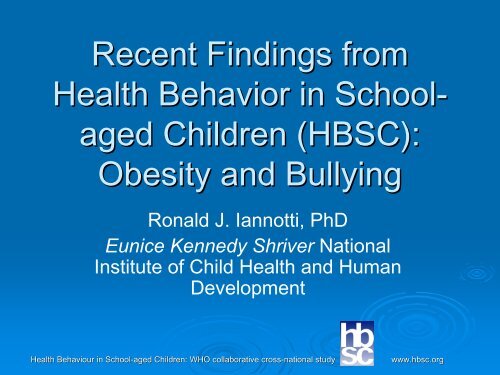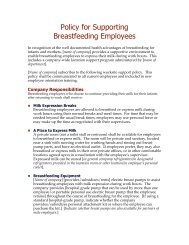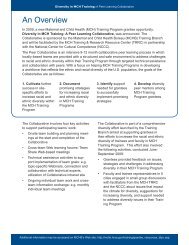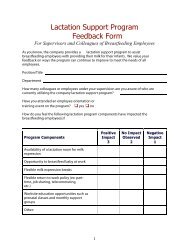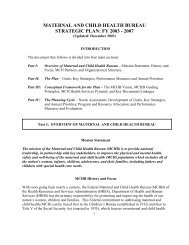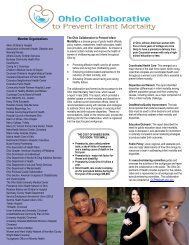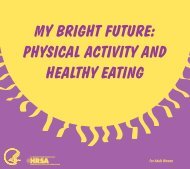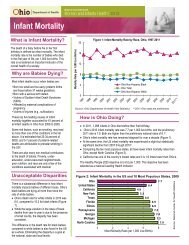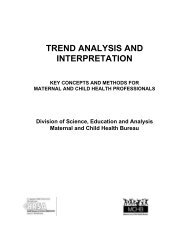Recent Findings from Health Behavior in School-aged Children ...
Recent Findings from Health Behavior in School-aged Children ...
Recent Findings from Health Behavior in School-aged Children ...
You also want an ePaper? Increase the reach of your titles
YUMPU automatically turns print PDFs into web optimized ePapers that Google loves.
<strong>Recent</strong> <strong>F<strong>in</strong>d<strong>in</strong>gs</strong> <strong>from</strong><strong>Health</strong> <strong>Behavior</strong> <strong>in</strong> <strong>School</strong>-<strong>aged</strong> <strong>Children</strong> (HBSC):Obesity and Bully<strong>in</strong>gRonald J. Iannotti, PhDEunice Kennedy Shriver NationalInstitute of Child <strong>Health</strong> and HumanDevelopment<strong>Health</strong> Behaviour <strong>in</strong> <strong>School</strong>-<strong>aged</strong> <strong>Children</strong>: WHO collaborative cross-national study www.hbsc.org
Background‣ HBSC was <strong>in</strong>itiated <strong>in</strong> 1982 by three countries, shortlyafterwards adopted as a WHO collaborative study‣ Now has 43 member countries/regions <strong>in</strong> Europe andNorth America‣ A collaborative project between national research teamsand <strong>in</strong> partnership with WHO‣ Surveys 11-, , 13-, , and 15-yearyear-olds every 4 years<strong>in</strong>clud<strong>in</strong>g a standard <strong>in</strong>ternational questionnaire <strong>in</strong> allcountries (latest survey 2005– 2006; 2009-2010 2010 <strong>in</strong>plann<strong>in</strong>g)<strong>Health</strong> Behaviour <strong>in</strong> <strong>School</strong>-<strong>aged</strong> <strong>Children</strong>: WHO collaborative cross-national study www.hbsc.org
<strong>Health</strong> <strong>Behavior</strong> <strong>in</strong> <strong>School</strong>-Aged <strong>Children</strong> – 2005/6:Participat<strong>in</strong>g Countries<strong>Health</strong> Behaviour <strong>in</strong> <strong>School</strong>-<strong>aged</strong> <strong>Children</strong>: WHO collaborative cross-national study www.hbsc.org
Broad Aims of HBSC‣ To <strong>in</strong>crease understand<strong>in</strong>g of youngpeople's health and well-be<strong>in</strong>g, healthbehaviors and their social context‣ To <strong>in</strong>form and <strong>in</strong>fluence policy andpractice at national and <strong>in</strong>ternational levels<strong>Health</strong> Behaviour <strong>in</strong> <strong>School</strong>-<strong>aged</strong> <strong>Children</strong>: WHO collaborative cross-national study www.hbsc.org
Obesity - An Epidemic‣ At every age, U.S. boys (34%) were morelikely to be overweight or obese than youth<strong>in</strong> 39 other developed countries(International boys - 16%)‣ Compared to girls <strong>in</strong> the other countries,U.S. girls ranked second (U.S. girls - 26%vs. International girls - 11%)<strong>Health</strong> Behaviour <strong>in</strong> <strong>School</strong>-<strong>aged</strong> <strong>Children</strong>: WHO collaborative cross-national study www.hbsc.org
Obesity - Diet‣ A significantly larger percentage of U.S.children (20%) ate two or more serv<strong>in</strong>gs offruit every day than children <strong>from</strong> othercountries (International average - 18%)‣ But the <strong>Health</strong>y People 2010 goal is for75% of the U.S. population 2 years andolder to eat at least 2 serv<strong>in</strong>gs of fruit aday<strong>Health</strong> Behaviour <strong>in</strong> <strong>School</strong>-<strong>aged</strong> <strong>Children</strong>: WHO collaborative cross-national study www.hbsc.org
Obesity - Diet‣ Evidence shows that consumption of softdr<strong>in</strong>ks is related to adiposity and seculartrends <strong>in</strong>dicate an <strong>in</strong>crease <strong>in</strong> soft dr<strong>in</strong>kconsumption by U.S. children‣ A significantly larger percentage of U.S.children (36%) drank soft dr<strong>in</strong>ks every daythan children <strong>from</strong> other countries(International average - 25%)<strong>Health</strong> Behaviour <strong>in</strong> <strong>School</strong>-<strong>aged</strong> <strong>Children</strong>: WHO collaborative cross-national study www.hbsc.org
Obesity - Eat<strong>in</strong>g Patterns‣ HBSC data show that eat<strong>in</strong>g breakfast isrelated to better weight control and eat<strong>in</strong>gat fast food restaurants is associated withobesity‣ U.S. students are less likely to eatbreakfast every day than 80% of thecountries surveyed‣ 45% of U.S. students said they eat at fastfood restaurants at least once a week<strong>Health</strong> Behaviour <strong>in</strong> <strong>School</strong>-<strong>aged</strong> <strong>Children</strong>: WHO collaborative cross-national study www.hbsc.org
Obesity - Diet<strong>in</strong>g‣ U.S. boys ranked number one (19%) ondiet<strong>in</strong>g to lose weight compared to allother countries‣ U.S. girls rank among the top countries ondiet<strong>in</strong>g to lose weight (25% at age 11, 29%at age 13, and 26% at age 15)<strong>Health</strong> Behaviour <strong>in</strong> <strong>School</strong>-<strong>aged</strong> <strong>Children</strong>: WHO collaborative cross-national study www.hbsc.org
Physical Activity (PA)‣ U.S. boys were <strong>in</strong> the top 10% for physicalactivity among 13- and 15-yearyear-old boys<strong>in</strong>ternationally‣ The percent of U.S. girls meet<strong>in</strong>g nationalguidel<strong>in</strong>es for moderate to vigorousphysical activity decreases with age (<strong>from</strong>26% at age 11 to 14% at age 15)<strong>Health</strong> Behaviour <strong>in</strong> <strong>School</strong>-<strong>aged</strong> <strong>Children</strong>: WHO collaborative cross-national study www.hbsc.org
Sedentary <strong>Behavior</strong> (SB)‣ A significantly larger percentage of U.S.children (66%) met the recommendationsfor watch<strong>in</strong>g less than 2 hours of TV perday than children <strong>from</strong> other countries(International average - 64%)‣ The <strong>Health</strong>y People 2010 goal for U.S.high school students is to <strong>in</strong>crease thisnumber to 75%<strong>Health</strong> Behaviour <strong>in</strong> <strong>School</strong>-<strong>aged</strong> <strong>Children</strong>: WHO collaborative cross-national study www.hbsc.org
Physical Activity and <strong>Health</strong>Indices‣ Physical activity and sedentary behaviorsare relatively <strong>in</strong>dependent and havedifferent correlates‣ Across 5 regions of North America andEurope, PA was positively related to 5<strong>in</strong>dices of positive physical, psychological,and social health<strong>Health</strong> Behaviour <strong>in</strong> <strong>School</strong>-<strong>aged</strong> <strong>Children</strong>: WHO collaborative cross-national study www.hbsc.org
Sedentary <strong>Behavior</strong>s and <strong>Health</strong>Indices‣ Across 5 regions of North America andEurope, sedentary behavior wasnegatively related to Self-Image‣ Sedentary behavior was positively relatedto <strong>Health</strong> Compla<strong>in</strong>ts, PhysicalAggression, and Alcohol Use across allregions<strong>Health</strong> Behaviour <strong>in</strong> <strong>School</strong>-<strong>aged</strong> <strong>Children</strong>: WHO collaborative cross-national study www.hbsc.org
Fight<strong>in</strong>g‣ A significantly smaller percentage of U.S.children (10%) were <strong>in</strong> a physical fight 3+ times<strong>in</strong> the last 12 months than children <strong>from</strong> othercountries (International average - 14%)‣ 37% of U.S. students respond<strong>in</strong>g to the HBSCsurvey eng<strong>aged</strong> <strong>in</strong> a fight at least once <strong>in</strong> thelast 12 months‣ The <strong>Health</strong>y People 2010 goal is to reduce theproportion of students <strong>in</strong> grades 9 to 12 whoengage <strong>in</strong> a physical fight <strong>in</strong> the last 12 monthsto 32%<strong>Health</strong> Behaviour <strong>in</strong> <strong>School</strong>-<strong>aged</strong> <strong>Children</strong>: WHO collaborative cross-national study www.hbsc.org
Bully<strong>in</strong>g‣ Previously, U.S. students were more likely to bebullied or to have bullied others compared to theall-country average for bully<strong>in</strong>g‣ In 2005/6, 11% of U.S. school children had beenbullied at least twice <strong>in</strong> the last two monthswhich is below the <strong>in</strong>ternational average‣ S<strong>in</strong>ce 1997/8, bully<strong>in</strong>g decreased <strong>in</strong> the U.S. but<strong>in</strong>creased or didn’t t change <strong>in</strong> prevalence <strong>in</strong> allother English-speak<strong>in</strong>g speak<strong>in</strong>g countries participat<strong>in</strong>g <strong>in</strong>HBSC<strong>Health</strong> Behaviour <strong>in</strong> <strong>School</strong>-<strong>aged</strong> <strong>Children</strong>: WHO collaborative cross-national study www.hbsc.org
U.S. Trends <strong>in</strong> Occasional Bully<strong>in</strong>gand Victimization504045403530252015101997/82001/22005/63530252015101997/82001/22005/6550Boys *Girls0Boys *Girls*Secular trend p
U.S. Trends <strong>in</strong> Chronic Bully<strong>in</strong>gand Victimization2518162014151997/812101997/8102001/22005/6862001/22005/65420Boys *Girls0Boys *Girls*Secular trend p
Thank YouQuestions about the study can be directed toRonald Iannotti at: iannottr@mail.nih.gov<strong>Health</strong> Behaviour <strong>in</strong> <strong>School</strong>-<strong>aged</strong> <strong>Children</strong>: WHO collaborative cross-national study www.hbsc.org


